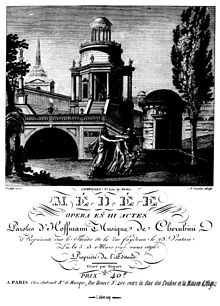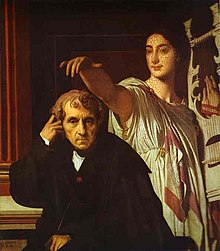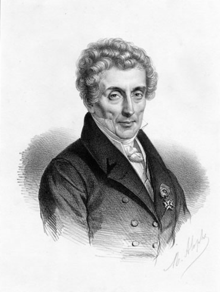Luigi Cherubini
Luigi Cherubini | |
|---|---|
 Portrait of Cherubini with a bust of his mentor,Giuseppe Sarti,byFrançois Dumont(1792). | |
| Born | Maria Luigi Carlo Zenobio Salvatore Cherubini September 8, 1760 Florence,Italy |
| Died | March 15, 1842(aged 81) Paris,France |
| Era | Classical, Romantic |
Maria Luigi Carlo Zenobio Salvatore Cherubini(/ˌkɛrʊˈbiːni/KERR-uu-BEE-nee;Italian:[luˈiːdʒikeruˈbiːni];8 or 14 September[1]1760 – 15 March 1842) was an ItalianClassicalandRomantic[2][3]composer. His most significant compositions are operas and sacred music.Beethovenregarded Cherubini as the greatest living composer of his era. Cherubini's operas were heavily praised and interpreted byRossini.[4]
Early years[edit]
Cherubini was bornMaria Luigi Carlo Zenobio Salvatore CherubiniinFlorencein 1760. There is uncertainty about his exact date of birth. Although 14 September is sometimes stated, evidence from baptismal records and Cherubini himself suggests the 8th is correct. Perhaps the strongest evidence is his first name, Maria, which is traditional for a child born on 8 September, the feast-day of the Nativity of the Virgin.[1]His instruction in music began at the age of six with his father, Bartolomeo,maestro al cembalo( "Master of theharpsichord",in other words, ensemble leader from theharpsichord). Considered achild prodigy,Cherubini studiedcounterpointand dramatic style at an early age. By the time he was thirteen, he had composed several religious works.
Adulthood and first operas[edit]
In 1780, he was awarded a scholarship by theGrand Duke of Tuscanyto study music inBolognaandMilan.[1]Cherubini's earlyopere serieused libretti byApostolo Zeno,Metastasio(Pietro Trapassi), and others that adhered closely to standard dramatic conventions. His music was strongly influenced byNiccolò Jommelli,Tommaso Traetta,andAntonio Sacchini,who were the leading Italian composers of the day. The first of his two comic works,Lo sposo di tre e marito di nessuna,premiered at aVenetiantheater in November 1783.[1]
Feeling constrained by Italian traditions and eager to experiment, Cherubini traveled to London in 1785 where he produced twoopere serieand anopera buffafor theKing's Theatre.In the same year, he made an excursion to Paris with his friend the violinistGiovanni Battista Viotti,who presented him toMarie Antoinetteand Parisian society. Cherubini received an important commission to writeDémophoonto a French libretto byJean-François Marmontelthat would be his firsttragédie en musique.Except for a brief return trip to London and toTurinfor anopera seriacommissioned by KingVictor Amadeus III,Cherubini spent the rest of his life inFrance[1]where he was initiated intoGrand Orient de France"Saint-Jean de Palestine" Masonic Lodge in 1784.
French assimilation[edit]

Cherubini adopted the French version of his name,Marie-Louis-Charles-Zénobi-Salvador Cherubini;this appears inallextant documents that show his full name after 1790,[1]though his Italian name is favored nowadays. Performances ofDémophoonwere favorably received at the Académie Royale de Musique in 1788. With Viotti's help, theThéâtre de Monsieurin theTuileriesappointed Cherubini as its director in 1789. Three years later, after a move to the rue Feydeau and the fall of the monarchy, the company became known as the Théâtre Feydeau. This position gave Cherubini the opportunity to read countless libretti and choose one that best suited his temperament.
Cherubini's music began to show more originality and daring. His first major success wasLodoïska(1791), which was admired for its realistic heroism. This was followed byElisa(1794), set in theSwiss Alps,andMédée(1797), Cherubini's best-known work.Les deux journées(1800), in which Cherubini simplified his style, was a popular success. These and other operas were premièred at the Théâtre Feydeau or the Opéra-Comique. Feeling financially secure, he married Anne Cécile Tourette in 1794 and began a family of three children.
The fallout from theFrench Revolutionaffected Cherubini until the end of his life. Politics forced him to hide his connections with the former aristocracy and seek governmental appointments. AlthoughNapoleonfound him too complex, Cherubini wrote at least one patriotic work per year for more than a decade.[1]He was appointed Napoleon's director of music inViennafor part of 1805 and 1806, whereupon he conducted several of his works in that city.
In 1808 Cherubini was elected an associated member of theRoyal Institute of the Netherlands.[5]
From opera to church music[edit]

AfterLes deux journées,Parisian audiences began to favor younger composers such asBoieldieu.Cherubini's opera-balletAnacréonwas an outright failure and most stage works after it did not achieve success.Faniska,produced in 1806, was an exception, receiving an enthusiastic response, in particular byHaydnand Beethoven.Les Abencérages(1813), an heroic drama set in Spain during the last days of theMoorishkingdom ofGranada,was Cherubini's attempt to compete withSpontini'sLa vestale;it received critical praise but few performances.
Disappointed with his lack of acclaim in the theater, Cherubini turned increasingly to church music, writing sevenmasses,tworequiems,and many shorter pieces. During this period (under therestored monarchy) he was appointedSurintendant de la Musique du Roi,a position he would hold until the fall ofCharles X(1830). In 1815 London'sRoyal Philharmonic Societycommissioned him to write a symphony, an overture, and a composition for chorus and orchestra, the performances of which he went especially to London to conduct, increasing his fame.
Cherubini'sRequiem in C minor(1816), commemorating the anniversary of the execution of KingLouis XVI of France,was a huge success. The work was greatly admired by Beethoven,SchumannandBrahms.In 1836, Cherubini wrote a Requiem in D minor to be performed at his own funeral. It is for male choir only, as the religious authorities had criticised his use of female voices in the earlier work.
Later years and legacy[edit]


In 1822, Cherubini became director of theConservatoireand completed his textbook,Cours de contrepoint et de fugue,in 1835. His role at the Conservatoire brought him into conflict with the youngHector Berlioz,who portrayed the old composer in his memoirs as a crotchety pedant. Some critics, such as Basil Deane, maintain that Berlioz's depiction has distorted Cherubini's image with posterity. There are many allusions to Cherubini's personal irritability among his contemporaries;Adolphe Adamwrote, "some maintain his temper was very even, because he was always angry." Nevertheless, Cherubini had many friends, includingSzymanowska,Rossini,Chopinand, above all, the artistIngres.The two had mutual interests: Cherubini was a keen amateur painter and Ingres enjoyed practising the violin. In 1841, Ingres produced the most celebrated portrait of the old composer.
Although chamber music does not make up a large portion of his output, what he did write was important.Wilhelm Altmann,writing in hisHandbuch für Streichquartettspieler(Handbook for String Quartet Players) about Cherubini's six string quartets, stated that they are first rate and regarded Nos. 1 and 3 as masterworks. His String Quintet for two violins, viola and two cellos is also considered a first-rate work.
During his lifetime, Cherubini received France's highest and most prestigious honors. These included theChevalier de laLégion d'honneur(1814) andMembre de l'Académie des Beaux-Arts(1815). In 1841, he was madeCommandeur de la Légion d'honneur,the first musician to receive that title.[6]
Cherubini died in Paris in 1842 at age 81 and is buried atPère Lachaise Cemetery,just four metres from his friend Chopin. His tomb was designed by the architectAchille Leclèreand includes a figure by the sculptorAugustin-Alexandre Dumontrepresenting "Music" crowning a bust of the composer with a wreath.
Works[edit]
Orchestral music[edit]
- Overture in G(1815)
- Symphony in D major (1815)
- Marche funèbre (1820)
Chamber music[edit]
- String Quartet No. 1 in E-flat (1814)
- String Quartet No. 2 in C (1829) - transcription of Symphony in D major with new second movement
- String Quartet No. 3 in D minor (1834)
- String Quartet No. 4 in E (1835)
- String Quartet No. 5 in F (1835)
- String Quartet No. 6 in A minor (1837)
- String Quintet (2 violins, viola, 2 cellos) in E minor (1837)
Masses and sections of the Mass[edit]
- Five masses (written 1773–1776, lost)
- Messe solennelle brèvein B-flat (1805, dubious)
- Credoa capellafor eight voices and organ (1806)
- Mass in A for three voices (1809, dubious)
- Messe de Chimayin F (1809)
- Missa solemnisin D minor (1811)per ilPrincipe Esterházy
- Mass (4th messe solennelle) in C (1816)
- Credo in D (1816)
- Requiem in C minorfor mixed chorus (1816) in memory of Louis XVI
- Missa solemnisin E (1818)
- Mass in G (1819) for the Coronation of Louis XVIII
- Mass in B-flat (1821, dubious)
- Messe solennellein A for theCoronation of Charles X(1825)
- Requiem in D minor for male chorus (1836) written for his own funeral[7]
Motets and other choral works[edit]
- CantataAmphion(1786)
- CantataCircé(premiered 1789)
- Trois chœrs:Incidental music for the playLa Mort de MirabeaubyJean-Baptiste Pujoulx(1791)
- CantataClytemnestra(1794)
- CantataHymne au printemps( "Hymn to Spring" ) (1815)
- Hymne du Panthéon(1794)[8]
- 38 motets
Operas[edit]
Teaching manuals[edit]
References[edit]
Citations[edit]
- ^abcdefgWillis, in Sadie (Ed.), p. 833
- ^"Luigi Cherubini | Biography, Compositions, & Facts | Britannica".10 September 2023.
- ^"There are clearly Romantic characteristics in his operaMédée,e.g. in many daring harmonic progressions. "Sohlmans Musiklexikon
- ^Holden, p. 174
- ^"Marie Louis Charles Zenobie Salvator Cherubini (1760 - 1842)".Royal Netherlands Academy of Arts and Sciences.Retrieved5 October2016.
- ^Willis, in Sadie (ed.), p. 834
- ^Deane p.30
- ^Hymne du Panthéon: Grand Chœur à la gloire des martyrs de la liberté et de ses défenseurs,lyrics byMarie-Joseph Chénier,composed in 1794 in to celebrate Marat's death (Cf.Cherubiniin Dictionnaire de la musique, by Gérard Pernon, page 57).
Sources[edit]
- Altmann, Wilhelm,Handbuch für Streichquartettspielers,Amsterdam: Hinrichtshofen, 1972
- Cherubini, Luigi (withFromental Halévy,Cours de contrepoint et de fugue,Paris: M. Schlesinger, 1835 OCLC 11909698
- Deane, Basil,Cherubini(Oxford Studies of Composers, 1965)
- Cobbett, W.W. (Ed.),Cobbett's Cyclopedic Survey of Chamber Music,Oxford University Press, 1963.
- Holden, Amanda(Ed.),The New Penguin Opera Guide,New York: Penguin Putnam, 2001.ISBN0-14-029312-4.
- Willis, Stephen C.,"Cherubini, (Maria) Luigi (Carlo Zanobi Salvadore)" in Sadie, Stanley (Ed.),The New Grove Dictionary of Opera,Vol. 1, A-D, New York: MacMillan, 1994.ISBN0-935859-92-6.
External links[edit]
- Entry for Luigi Cherubini inThe Catholic Encyclopedia
- Luigi Cherubini String Quartet Nos.1 & 3, and String Quintet--sound-bites and discussion of works
- Free scores by Luigi Cherubiniat theInternational Music Score Library Project(IMSLP)
- Free scores by Luigi Cherubiniin theChoral Public Domain Library(ChoralWiki)
- 1760 births
- 1842 deaths
- 19th-century Italian male musicians
- Burials at Père Lachaise Cemetery
- Catholic liturgical composers
- Italian classical composers of church music
- Commanders of the Legion of Honour
- Academic staff of the Conservatoire de Paris
- Directors of the Conservatoire de Paris
- Italian Classical-period composers
- Italian music theorists
- Italian opera composers
- Italian male opera composers
- Italian string quartet composers
- Members of the Royal Netherlands Academy of Arts and Sciences
- Musicians from Florence
